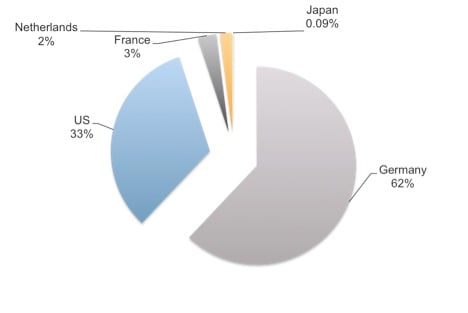XcodeGhost S: A New Breed Hits the US
https://www.ispeech.org/text.to.speech
Just over a month ago, iOS users were warned of the threat to their
devices by the XcodeGhost malware. Apple quickly reacted, taking down
infected apps from the App Store and releasing new security features
to stop malicious activities. Through continuous monitoring of our
customers’ networks, FireEye researchers have found that, despite the
quick response, the threat of XcodeGhost has maintained persistence
and been modified.
More specifically, we found that:
- XcodeGhost has entered into U.S. enterprises and is a
persistent security risk - Its botnet is still partially
active - A variant we call XcodeGhost S reveals more advanced
samples went undetected
After monitoring XcodeGhost related activity for four weeks, we
observed 210 enterprises with XcodeGhost-infected applications running
inside their networks, generating more than 28,000 attempts to connect
to the XcodeGhost Command and Control (CnC) servers -- which, while
not under attacker control, are vulnerable to hijacking by threat
actors. Figure 1 shows the top five countries XcodeGhost attempted to
callback to during this time.
Figure 1. Top five countries XcodeGhost
attempted to callback in a four-week span
The 210 enterprises we detected with XcodeGhost infections represent
a wide range of industries. Figure 2 shows the top five industries
affected by XcodeGhost, sorted by the percentage of callback attempts
to the XcodeGhost CnC servers from inside their networks:

Figure 2: Top five industries affected based on
callback attempts
Researchers have demonstrated how XcodeGhost CnC traffic can be
hijacked to:
- Distribute apps outside the App Store
- Force browse to
URL - Aggressively promote any app in the App Store by
launching the download page directly - Pop-up phishing
windows
Figure 3 shows the top 20 most active infected apps among 152 apps,
based on data from our DTI cloud:

Figure 3: Top 20 infected apps
Although most vendors have already updated their apps on App Store,
this chart indicates many users are actively using older, infected
versions of various apps in the field. The version distribution varies
among apps. For example, the most popular Apps 网易云音乐 and
WeChat-infected versions are listed in Figure 4.
|
App Name |
Version |
Incident Count (in 3 weeks) |
|
|
6.2.5.19 |
2963 |
|
网易云音乐 Music 163 |
2.8.2 |
3084 |
|
2.8.3 |
2664 |
|
|
2.8.1 |
1227 |
Figure 4: Sample infected app versions
The infected iPhones are running iOS versions from 6.x.x to 9.x.x as
illustrated by Figure 5. It is interesting to note that nearly 70% of
the victims within our customer base remain on older iOS versions. We
encourage them to update to the latest version iOS 9 as quickly as possible.

Figure 5: Distribution of iOS versions running
infected apps
Some enterprises have taken steps to block the XcodeGhost DNS query
within their network to cut off the communication between employees’
iPhones and the attackers’ CnC servers to protect them from being
hijacked. However, until these employees update their devices and
apps, they are still vulnerable to potential hijacking of the
XcodeGhost CnC traffic -- particularly when outside their corporate networks.
Given the number of infected devices detected within a short period
among so many U.S enterprises, we believe that XcodeGhost continues to
be an ongoing threat for enterprises.
XcodeGhost Modified to Exploit iOS 9
We have worked with Apple to have all XcodeGhost and XcodeGhost S
(described below) samples we have detected removed from the App Store.
XcodeGhost is planted in different versions of Xcode, including
Xcode 7 (released for iOS 9 development). In the latest version, which
we call XcodeGhost S, features have been added to infect iOS 9 and
bypass static detection.
According to [1], Apple introduced the “NSAppTransportSecurity”
approach for iOS 9 to improve client-server connection security. By
default, only secure connections (https with specific ciphers) are
allowed on iOS 9. Due to this limitation, previous versions of
XcodeGhost would fail to connect with the CnC server by using http.
However, Apple also allows developers to add exceptions
(“NSAllowsArbitraryLoads”) in the app’s Info.plist to allow http
connection. As shown in Figure 6, the XcodeGhost S sample reads the
setting of “NSAllowsArbitraryLoads” under the “NSAppTransportSecurity”
entry in the app’s Info.plist and picks different CnC servers
(http/https) based on this setting.

Figure 6: iOS 9 adoption in XcodeGhost S
Further, the CnC domain strings are concatenated character by
character to bypass the static detection in XcodeGhost S, such
behavior is shown in Figure 7.

Figure 7: Construct the CnC domain character by character
The FireEye iOS dynamic analysis platform has successfully detected
an app (“自由邦”) [2] infected by XcodeGhost S and this app has been
taken down from App Store in cooperation with Apple. It is a shopping
app for travellers and is available on both U.S. and CN App Stores. As
shown in Figure 8, the infected app’s version is 2.6.6, updated on
Sep. 15.

Figure 8: An App Store app is infected with
XcodeGhost S
Enterprise Protection
FireEye MTP has
detected and assisted in Apple’s takedown of thousands of
XcodeGhost-infected iOS applications. We advise all organizations to
notify their employees of the threat of XcodeGhost and other malicious
iOS apps. Employees should make sure that they update all apps to the
latest version. For the apps Apple has removed, users should remove
the apps and switch to other uninfected apps on App Store.
FireEye MTP management
customers have full visibility into which mobile devices are infected
in their deployment base. We recommend that customers immediately
review MTP alerts, locate infected devices/users, and quarantine the
devices until the infected apps are removed. FireEye NX customers are
advised to immediately review alert logs for activities related to
XcodeGhost communications.
[1] https://developer.apple.com/library/prerelease/ios/technotes/App-Transport-Security-Technote/
[2] https://itunes.apple.com/us/app/id915233927
[3] http://drops.wooyun.org/papers/9024
[4] https://itunes.apple.com/us/app/pdf-reader-annotate-scan-sign/id368377690?mt=8
[5] https://itunes.apple.com/us/app/winzip-leading-zip-unzip-cloud/id500637987?mt=8
[7] https://www.fireeye.com/blog/threat-research/2015/08/ios_masque_attackwe.html
[8] https://www.fireeye.com/blog/threat-research/2015/02/ios_masque_attackre.html
[9] https://www.fireeye.com/blog/threat-research/2014/11/masque-attack-all-your-ios-apps-belong-to-us.html
[10] https://www.fireeye.com/blog/threat-research/2015/06/three_new_masqueatt.html








Gloss